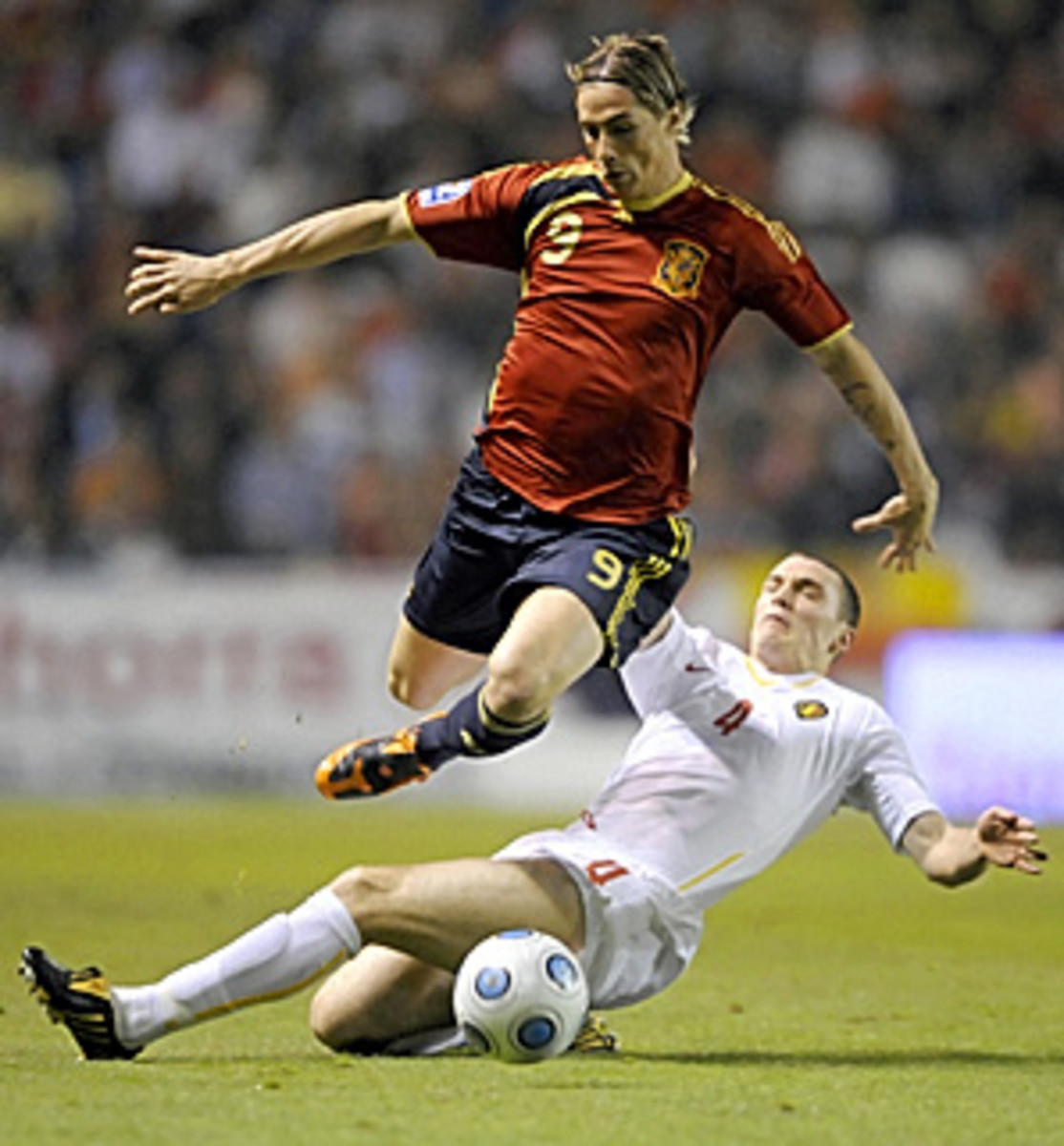
Absence of one of the world's best strikers actually could help Spain
Manager Vicente del Bosque, like Luis Aragones before him, has been reluctant to choose between them and the result is that Spain, as the U.S. exposed in the Confederations Cup last June, is vulnerable. Perversely, the knee injury that looks likely to keep Torres out of the start of the World Cup may be to Spain's advantage.
There is still, bewilderingly, a habit among some pundits of complaining when sides play with only "one up" as being overly defensive. But that's not the case if it allows you to play a profusion of gifted attacking midfielders. The modern trend is to use five-man midfields (in various permutations) and a single central striker. That has two major advantages. There is the obvious point that an additional man in midfield makes it easier for a side to dominate possession, but it also gives teams additional attacking flexibility, allowing them to mount raids from an increased range of angles and depths.
This is an excellent Spain side that fully deserves to stand alongside Brazil as favorites for the World Cup, but the 4-1-3-2 shape it has preferred can leave it narrow in midfield and dependent on the fullbacks, Joan Capdevila and especially Sergio Ramos, to provide attacking width. As U.S. coach Bob Bradley showed in Bloemfontein last year, it is possible to disrupt that.
Orthodoxy would suggest fielding a fifth midfielder to try to outnumber Spain in central areas, but Bradley took a more offensive route, fielding a 4-4-2, in which Jozy Altidore occupied Spain's center backs largely by being big and burly, and the pacy Charlie Davies made a series of diagonal runs behind Ramos, making him wary of pushing too far forward.
The differing physical threat of the two forwards unsettled Carles Puyol and Gerard Pique to the extent that Xabi Alonso, playing at the base of Spain's diamond midfield, had to help out defensively, which is not his strong point -- and his retreat effectively took half a man out of midfield, giving the U.S. an advantage. Given Spain's lack of width, the U.S. could play a narrow midfield four, squeezing the game and disrupting the usually fluent passing of Xavi and Cesc Fabregas by dint of the number of bodies in central areas.
With the U.S. effectively surrendering the flanks, Spain did at times find room in wide areas, but Jay DeMerit had the game of his life, dominating Torres in the air and repelling what crosses were delivered. Of course, the U.S. rode its luck to an extent -- Spain had 29 shots to the USA's nine; goalkeeper Tim Howard made a number of fine saves; Ricardo Clark pulled off one barely credible block; and Xavi should have had a penalty when he was bundled over by Landon Donovan -- but its diligence brought a team that had gone unbeaten in 35 games down to the level where the U.S. could engage it in a meaningful contest. Most of Spain's opponents this summer would be happy enough with that.
The flip side of that was seen at the 2008 European Championship in which Spain, paradoxically, played its best football after Villa, the tournament's top scorer, had suffered an injury 34 minutes into the semifinals against Russia. In the group stage, Spain had enjoyed a flattering 4-1 win over Russia, edged past Sweden and then, having qualified, played a second string against Greece. The first team returned for an ugly penalty shootout win over Italy in the quarterfinals.
In that opening half-hour against Russia, Spain had been troubled by the attacking surges of the two fullbacks, Alexander Anyukov and Yuri Zhirkov, and had struggled to take control of midfield. Once Fabregas came on for Villa, though, Spain's shape changed from 4-1-3-2 to 4-1-4-1. Russia's fullbacks were pinned back by the width provided by Fabregas and David Silva and, with Marcos Senna neutralizing Andrei Arshavin, Spain took complete control, going on to win 3-0. The same formation was retained for the final and, although Spain beat Germany only 1-0, its superiority was evident.
Using only one forward also gives Spain greater tactical options. Del Bosque could play a similar 4-1-4-1 to that used toward the end of Euro 2008, with either Alonso or the more defensive Sergio Busquets in the holding role according to the requirements of the individual game. Or he could opt for a 4-2-3-1, in which case the two holders could be Alonso and Busquets, or Xavi could be pushed into a deeper role.
Neither Real Madrid not Barcelona habitually plays with more than a single forward, and it was telling at the Euros that while only eight teams began with a lone striker, 11, including the two finalists, changed -- or were forced to change -- to that system over the course of the tournament. Spain's dilemma is really evidence of the strength of the squad -- what other country, after all, would virtually be left to make a choice between Fabregas and Torres?
Of course, Torres, considering his ability playing with his back to goal, would be the more natural fit for the lone striking role, and certainly his aerial presence will be missed. Spain, like Barcelona, must be conscious that however good its Plan A is, it's always advantageous to have a Plan B.
But his injury may help Del Bosque make the decision to switch to five in midfield, something that would, by having essentially been forced upon him, absolve him from any media criticism for leaving out such an iconic player. If Spain starts well, Del Bosque can then retain a winning team, with the knowledge he has Torres as an additional option for later in the tournament. By robbing it of one of the best strikers in the world, Torres' knee injury may just make Spain even more formidable.




